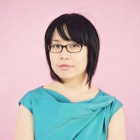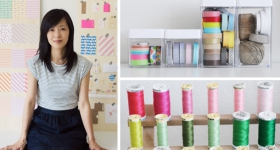In the painted world of Shahzia Sikander, veils float, griffins stare, and bodies twist in ethereal, layered landscapes. Sikander, a native of Lahore, Pakistan, has pioneered a revival in the traditional and highly stylized form of Indian and Persian miniature painting by imbuing it with her own personal context and history.
The 33-year-old New Yorker often juxtaposes images from the Hindu and Muslim worlds, exploring the boundaries between them. The role of women figures largely in her paintings and site-specific installations, a concern that's reflected in her choice of materials: vegetable color, tea, and handmade paper.
Sikander came to the United States nearly a decade ago for a show at the Pakistani Embassy and stayed to study at the Rhode Island School of Design. She then attended the prestigious two-year, post-grad Core program at Houston's Museum of Fine Arts before settling in New York. In 1997, her work was included in the Whitney Museum of Art Biennial Exhibition. An exhibit of her work curated by the Asia Society is traveling to several U.S. locations this year.
How have you changed miniature painting, which is an historic and traditional art form?
I've done various experiments with it. Right now I'm working with more digital movies and animation but using the same sort of language of painting and drawing, but then working it into a digital medium. My work's always been about creating a relationship with the traditional in a non-traditional medium. I like the relationship between both.
Why does this relationship interest you?
Initially, when I was attracted to [miniature painting] — this was 15 years ago — it was because it was a very misrepresented art form. Under the guise of a cultural heritage, a residual of it existed in terms of a very touristy and kitschy kind of aesthetic, primarily for tourist consumption. So one grew up with it, but I felt it was incorrect because one did not grasp its history. I got interested because I saw that it could be reintroduced as a contemporary medium.
You mix Muslim and Hindu iconography. Why?
I was attracted to a particular school which is the Akbah period in the 16th century. This school reflects extreme hybridity of the art form. . . . Growing up in Pakistan, having a distant relationship with India, and not necessarily being able to freely access Hindu culture, history, mythology or even pop culture — cultural things that were borrowed very freely, you were not even understanding the origins. Once I came out of that environment [by moving to the United States] and had a more neutral space, I was able to access that culture from another space. It's like you’re denied something so you're always attracted to it.
Do you think you get categorized in ways that you would not in Pakistan because you're a minority here in the States?
At many levels people sort of expect you to just continue with something that you have shown a few times. At the same time, I think it's inherent in this culture — like it's easier for understanding and grasping who one is and what is their work, and people tend to create categories. And those categories for me, I can understand they are important, but that can be very arbitrary as well. I think of them as very fluid, because they are constantly changing from South Asian to Asian American to gender-based, or because of the current climate, being Muslim becomes significant. Or not. These are dangerous things that happen outside the artist's control. . . . They do create frustrations on many levels, but then, they’re not something new. They've always been there. For instance, identity issues were very, very in vogue in the '90s. I remember being interested in that initially and then getting exhausted and moving on. It can be excessive and not very necessary in what you're thinking about while making the art, but it remains the accepted way for curators or writers to define art being made by people coming from a history of being colonized.










Comments